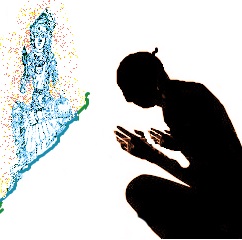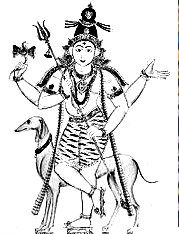
Origin and history of Goddess Kathayee
-Santhipriya-
Temple for Sithadi Goddess Kathayee Amman
Kanchamalai muni, an ardent disciple of Lord Shiva and disciple of saint Moolar was one amongst those who attended the marriage function of Lord Muruga with Goddess Deivanai and Goddess Valli. After witnessing the marriage, the muni came down to earth and sat in tapas. Kanchamalai muni knew the art of flying in air like birds and exponent in the art of Ashtami siddhi. Eight highest intellectual powers like spiritual, paranormal, supernatural, or magical powers, abilities, and attainments that are the products of spiritual advancement through sadhanas are called Ashtama Siddhi . It is heard that Kancha muni wore only clothes made of herbal leaves and remained in tapas for over 1000 years in a cave. He was also known as Kalangi Muni and was master to Saint Bhogar who made the Navabhashana statue of Lord Muruga enshrined in Palani hill in Tamilnadu.
Pleased with his tapas, Lord Shiva appeared before Kanchamalai Muni and instructed that he construct a temple for Goddess Valli in Siththadi in which separate sanctum sanctorum for Goddess Parvathi and Lord Muruga are also to be constructed since Goddess Valli was destined to stay there to aid Lord Muruga in his mission during Kali Yuga. Kanchamalai muni felt that though he had possessed mystic powers, without the help of humans it would not be possible for him to construct a shrine as instructed by Lord Siva, but he promised to carry out the orders and therefore immediately reached Sithadi which was then full of Thinai (millet) fields, in invisible form. Groups of huts were seen scattered here and there. Since most of the agriculturists in that area cultivated only millets the village was called land of millets.

Once Kanchamalai muni reached the village, he stood below a tree in invisible form and called a Brahmin walking at a distance away ‘son come here’. Hearing voice of invisible, the Brahmin walked towards the place from where the call came but could not find anyone there. When the Brahmin started walking back in panic, again the invisible called ‘son, do not get frightened, I have come here to guard the village. If you daily perform Pooja to me in this place I will guard this village’. Astonished Brahmin walked towards the tree from where the voice came and noticed heap of vermillion lying on the ground under the tree. He firmed up that some unknown deity hiding within the heap of vermillion might have only called him. Elated he believed that she may have come there to protect the village without knowing that the voice was that of Kanchamalai muni. Thus the first stage to establish a temple for Goddess Kathayee was successfully set by Kancha muni.

It is necessary to understand the kind of generalized atmosphere and beliefs that prevailed in bygone era. Every village used to have worship sites enshrined with Village deities called Grama devatha. Generally warriors in the village, or those who protected the villagers from atrocities of others or volunteered unconditional help in calamities etc were held in esteem by the villagers and honored by installing a small idol for them in the place where they were buried or lived and thereafter treated those places as sacred spots. Such idols or statues were village deities and periodical worship too offered. The general feeling of the villagers was that the pious souls stayed in their villages as Guardian Deities to protect and shield the village from attacks of not only evil Souls and Spirits, but also from natural calamities like flood, breaches in rivers, storm etc. The community feared that if such pious souls were disrespected they may in act of vengeance spread dreadful diseases or cause disasters causing misery and will thereafter remain mute spectator against natural disasters. The village community therefore treated the unknown souls as Guardian angels (Souls), Village Deity or Village God and worshiped them. The evil souls which wandered as Ghosts for the sins committed, if attempted to enter the villages would be driven off by the Guardian Deity of the villages, the community believed. Such beliefs led to the establishment and worship of Village Deity or Village God in the Villages.

On such belief, the Brahmin started worshiping the heap of vermillion from next day praying ‘Oh, mother only you have to protect this village’. He offered flowers to the heap of vermillion. Once Kanchamalai muni laid the path to build a worship place he immediately left the place after Goddess Valli manifested there in an invisible form to take over the rest of the process to get a temple established for her. Every day, after the Brahmin concluded his prayer, instantly by way of screeching sound of lizards, birds or some sounds of animal, she would indicate that his prayer has been accepted. As days passed, the Brahmin was troubled by a nagging thought. How could he protect the unknown deity residing inside the heap of Vermilion from the heat rays of the sun which fall over it? Concerned, he began to keep his hand over the vermillion heap like an umbrella to stop sun rays falling on it. Days passed.

Once the monsoon set in and rains started the Brahmin, was questioned by the mysterious voice as to how he was going to protect her from the rains. He had no answer to offer, thought of several options, but finally decided to cover the heap of vermillion with an idol made of clay and continued the prayers. The rains did not wash off the heap of vermillion kept below fairly big clay idol. After few days when he realized that the idol made of clay would also dissolve in rain, he sat in meditation praying the almighty to herself offer a permanent solution to protect her from fury of rains. The display of the power of divine was such that even though heavy rains lashed inundating the areas, the land around the tree and the vermillion heap mysteriously remained unaffected by the rains in any manner.

When awestruck Brahmin continued to offer prayers in the same place, one day he experienced inner vision began to over shadow his feelings and emotions by the appearance of several squares merging together displaying a female deity within, whose beauty could not be explained or expressed in plain words. The unknown deity was seen standing in the midst of triangles made in seven structures. In a short while the unknown deity spoke ‘my son, I am the same deity who governed the universe earlier and manifested here to protect the village. I am inside the river running nearby displayed with three head gears. If you take me out from inside the river and offer worship I will stay here to alleviate the sufferings of the people and protect the village as well.

Once the voice disappeared and the Brahmin came to his senses, the appearance of the deity too faded away from inner vision. Next morning the Brahmin went to the river bed, sat in the river bank watching the river all through the day till he suddenly saw bunch of three head gears floating and disappearing into the water. Once he saw the three headgear, quickly he jumped into the river and brought out the idol with three head gears. He took it to the same site where he had kept the heap of vermillion, constructed a small platform, spread the heap of vermillion collected from the previous spot where he was worshiping her, and enshrined the new idol in place of the old clay idol and began to worship it. He imagined her to be ‘Aye (elderly woman)’ who had manifested there to guard the village. The nick name Aye slowly became to be referred as Kathayee meaning the Aye who has come to guard the village.
Sometimes in anxiety, we commit certain mistakes unknowingly. Similarly the Brahmin too committed a sin. While clearing the old platform to install the new idol taken out from the river, he threw the old clay idol into the river feeling it was no more needed without even realizing for a moment that the old idol worshiped by him for so many days had only shielded the vermillion from getting washed in rain.
Next morning when the Brahmin concluded prayers and as usual waited to hear Aye acknowledging his prayer, only an eerie of silence continued. Shocked Brahmin when even after calling in loud voice ‘mother where are you… mother ..where are you, there was no response and she refused to appear before him. After some time an invisible voice came from the air asking him not to search for her anymore as she had already left the place along with the clay idol thrown into the river. He realized his foolish act, which of course was not intentional and cannot be redeemed since the clay would have completely dissolved into the water.
He began to cry aloud pardon explaining that the sinful act was not committed by him intentionally and committed out of ignorance. In spite of it, if she still refused to appear before him, he would have no other option but to tie the new idol with his body and jump into the river to commit suicide. Crying like a hapless child, he sought her pardon recalling how he had wholeheartedly and painstakingly plucked the flowers and offered pooja to the vermillion heap. Blaming his two legs which led him to the river bed to throw the clay idol, he began to do sit ups continuously and intensely even as blood began to ooze from the tissues in the legs. No mother would be able to witness the agony and distress of her child….she finally appeared before him in her true form- Goddess Kathayee- and blessed him.

She said ‘son, I admire your sincerity and pardoned you. I manifested in this land with three headgear, each one symbolizing mother of wisdom (Gnanambika), mother who attached in your heart (Ottiyaana roopini) and finally as mother to bless everyone with kind heart (Karunamayi). I promise that from now on I will stay here guiding and guarding all of you’. Saying so she merged into the new idol which he got from inside the river. Portraying these three aspects of her manifestation there she appears in the temple with three head gears.
Goddess Kathayee appeared before him the next day too to further instruct that since she was brought up by Nambirajan (nambi in Tamil meant belief) she would not let down anyone who surrendered to her and alleviate their sufferings by driving away the ignorance and evils in mind like how the birds were driven away from the millet field.
She expressed her desire to be in the company of Kanchamalai Muni, Lord Vinayaga and Lord Muruga besides Goddess Parvathi. Further she desired the seven munis like ‘Sem muni ’ with warm pink complexion, ‘Vazhu muni ’ who drives away evil thoughts, ‘Kumba muni ’ who guide one to get abundance wealth, ‘Lada muni ’ who guide in enhancing wisdom, ‘Jada muni ’ in yogic stature, ‘Natha muni ’ bless one in cool posture and ‘Muthu muni ’ who adorn garland of pearls all over his body be seated appropriately in her temple. According to the temple legend of Kovilur Goddess Kathayee Amman, the seven Munis were sons of Nambirajan who brought up Goddess Valli. There is another folklore that suggest that these seven munis were the guardian deities (parivara devathas) of Goddess Kathayee. In some of the villages folk songs are sung in the name of Kathayee Amman thavam (the tapas of Goddess Kathayee i.e waiting to marry Lord Muruga) and Mannarsaami Kathayee thirumanam. The song narrates the events of the marriage of Kathayee with Mannarsaami meaning King of Kings i.e Lord Muruga.

Outside the temple complex Kanchamalai Siva holding a lotus in his hand is seen in a separate sanctum sanctorum. His left hand is found kept over a cobra. It is interesting to see that Goddess Kathayini too hold a lotus in her hand in similar fashion. At different ends, statues for Veerabagu muni with Veeramitra bommi, nine saints, Lada sanyasi, Danvanthri muni, and Pechchayi Amman are seen installed. Vilva and neem trees are considered sacred trees of the temple.
Legend on Pachaivaazhi Amman (Kathayini)

Pachaivaazhi Amman (Kathayini) mother of Murugan too is seated in another sanctum sanctorum in the same temple. Several thousands of years ago when Goddess Parvathi had to take birth as human to redeem a curse on her, Maharishi Kathyayana who was in tapas sought Lord Siva’s grace to get Goddess Parvathi born to him as his daughter so that he could get her married to Lord Shiva. Strange wish. If we see the legends and stories in Purana, you will find that both the God and Goddesses have taken birth on earth as humans to redeem curses and thereafter attained their original status by marrying their spouses. Thus the same divine couples have married and remarried their own wives again and again with rebirths. In one such instance Goddess Parvathi had to redeem a curse and stay in Bhoologa. Keeping the same in mind, Lord Shiva granted the boon of Maharishi Kathyayana and ensured that Goddess Parvathi was born to him. When she attained marriageable age, she sat in tapas praying Lord Shiva to appear before and take her back as his consort. Satisfied with her tapas he appeared before Goddess Parvathi and in the presence of Rishis namely Siva, Dharma, Nada, Yoga, Vass, Puruda and few other great saints Lord Shiva married with her as per the wish of Maharishi Kathyayana. After marriage Goddess Kathayini sat in a separate sanctum in the temple of Goddess Kathayee where her curse was redeemed to marry Lord Shiva again. Thus it is believed that those who observed Kathayini Vrath (Fast) in this temple, the obstacles on their marriage gets removed and childless couples are rewarded with children.
End Note
In a village called Sengudi in Ramanathapuram district of Tamil Nadu there is a small Goddess Kathayee amman shrine. Some more villages where Goddess Kathayee amman is worshiped are Udayar kovil in Tanjavur district Pasumbadiyaar Goddess Kathayee amman temple, Sakkottai Goddess Kathayee amman Temple, Puthukkoattai Vallavaari Goddess Kathayee amman Temple, Thiruththuraipoondi Goddess Kathayee amman temple, Vaduvur Thenpathi Goddess Kathayee amman temple and another Goddess Kathayee amman temple in Sithadi village itself. Besides above the Velankanni magazhi vaaz Goddess Kathayee amman temple is also famous. But in all those temples Goddess Kathayee is worshiped only as Village deity.
Concluded









Thanks for giving the info on Sri Kathayee Amman’s history. Can I get slokas in Tamil or sanskrit on Kathayee Amman.